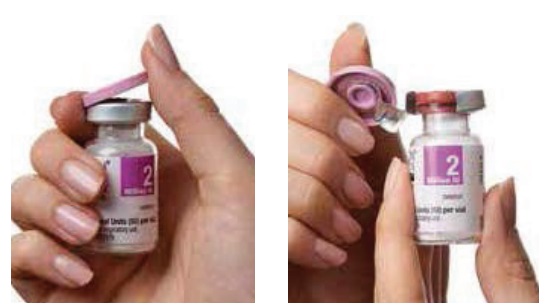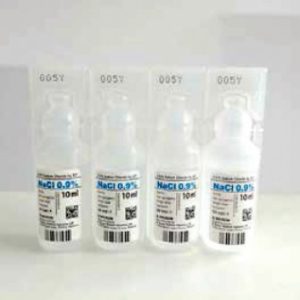Nebulised Colomycin therapy for non cystic bronchiectasis
Download and print as a PDF
Download- What is Nebulised Colomycin® and why have I been prescribed it?
- What is Pseudomonas?
- What is nebulised therapy?
- What are the side effects of nebulised therapy?
- How will I get my first dose?
- What dose do I need to take?
- What happens if I miss a dose?
- How do I prepare my nebulised Colomycin® dose?
- How do I assemble the nebuliser?
- How do I use the nebuliser machine?
- How long will I need to be on this antibiotic?
- Will I still be able to have this treatment if I get a chest infection?
- Who can I contact for support and information?
- Useful websites
What is Nebulised Colomycin® and why have I been prescribed it?
Colomycin® is an antibiotic used to treat Pseudomonas infection in the lung. It is also known as Colistin or colistimethate sodium.
Colomycin® is inhaled and administered via a nebuliser; research has shown that inhaled antibiotics can help reduce flare ups of lung conditions such as bronchiectasis and cystic fibrosis.
This leaflet gives you information about the treatment and how to administer it.
What is Pseudomonas?
Pseudomonas is a bacteria that can cause chest infections, particularly in people with weak immune systems and existing chest disease.
What is nebulised therapy?
Nebulised therapy is when medicine is given to you through a device called a nebuliser.
A nebuliser breaks down the medicine into smaller droplets. This allows the medicines to get to difficult to reach smaller airways of your lung.
It is more effective because it can help you receive a higher amount of your medicine to act directly in your lungs with fewer side effects.
In some cases, nebulised antibiotics will eliminate pseudomonas infection. However, sometimes it can be very difficult to treat and your doctor may decide to give you a course of intravenous antibiotics, if Colomycin® fails or in cases of severe infection.
What are the side effects of nebulised therapy?
The most common side effect is chest tightness or difficulty in breathing. This is called bronchospasm (the narrowing of your lung airways).
To make sure Colomycin® is safe and appropriate for you and to reduce this happening, the first dose will be given to you in hospital. You will be asked to use inhaled salbutamol (to help with your breathing) before each nebulised dose. If you are not on inhaled salbutamol we will show you how to use it and ask your GP to prescribe it for you.
When at home, if you experience difficulty in breathing after your dose, we recommend you stop this treatment for 2 to 3 days. If your symptoms improve, it is likely the nebulisers are the cause. Please contact us as soon as possible to review your treatment.
Other side effects include:
- Sore throat or mouth.
- Skin rashes.
- Coughing.
- Change in voice.
- Hoarseness
- Tinnitus (ringing in the ears).
- Increased phlegm (this could be discoloured or contain blood).
- Headache.
- Chest pain.
If you experience any of these side effects, please stop your nebulised therapy and contact the respiratory team (details at the end of this leaflet) or your GP.
How will I get my first dose?
Your first dose will be given in hospital.
We ask you to come to the Respiratory Clinic on the second floor of the Barry Building at the Royal Sussex County Hospital.
To make sure it is safe and appropriate for you, we will perform a ‘nebuliser trial’.
The trial consists of a series of tests:
- Performing a lung function test to assess how well your lungs work; this is called baseline spirometry.
- Giving you a medicine called salbutamol to help open up your airways also known as a bronchodilator. This will normally be given in the form of an inhaler. If you normally use this inhaler, please bring it with you on the day of the trial.
- Giving you the nebulised antibiotic; this can last 10 to 15 minutes.
- Repeating the spirometry test.
- Letting you rest for 20 minutes and then performing the spirometry test one final time.
If you live in the Brighton and Hove area (including Portslade and Saltdean), we will arrange for the Community Respiratory Service (CRS) to lend you a nebuliser. You will need to collect it from Brighton General Hospital. The team will explain how to mix the medication and prepare the nebuliser.
If you live outside Brighton, we will give you the equipment and teach you how to use it when you come to the Royal Sussex County Hospital. Not all areas have got a CRS who can provide nebulised therapy.
Once you have passed the trial, we will write to your GP who will be able to prescribe Colomycin®.
What dose do I need to take?
The usual dose will be 2 million units twice a day via your nebuliser device. This will be morning and evening, every 12 hours.
You will need:
- A nebuliser device.
- Colomycin® (available as a dry powder in a glass vial containing 2 million units per vial).
- Sodium Chloride 0.9% vials (to prepare the Colomycin® into a liquid form so it can be nebulised).
What happens if I miss a dose?
Do not worry. You should just take your next dose as scheduled. The chance of your chest getting worse due to one missed dose is very small.
How do I prepare my nebulised Colomycin® dose?
To prepare it you will need to take the following steps:

Nebulised Colomycin®
1 Wash hands thoroughly before preparing the medication.
2 Remove the red cup covering the vial by flipping the red plastic lid and peeling off the metal ring. You will then see a rubber bung completely exposed. Remove the rubber bung on the top of the vial and keep it to one side.
3 Twist and remove the top of the plastic vial of Sodium Chloride 0.9%. Squirt the contents into the Colomycin® vial.

Nebulised Colomycin® vials
4 Cover the vial again with the rubber bung and shake it gently so all the power is dissolved. If you shake it vigorously it is likely that you will get a foamy solution. If this happens leave it for a while to settle.

5 Pour the contents of the vial into the chamber that comes with the nebuliser set. This is the little container that twists below the blue section that attaches to the mouthpiece and the filter.

How do I assemble the nebuliser?
To assemble the nebuliser set make sure you follow the instructions in the leaflet that comes with it.
You will need to use a single use filter which is a white, round pad that is placed in the filter holder.
The nebuliser set once assembled should look like this:

Assembled nebuliser
After each use you will need to separate all the pieces and wash in warm soapy water. Rinse and let air dry. You do not need to sterilise the equipment.
Refer to the device instructions for further advice on how to look after your nebuliser set.
How do I use the nebuliser machine?
Once you have assembled the giving set and placed the medication in the container, you are ready to go.
Place the mouthpiece in your mouth, making sure you make a good seal with your lips. Press the on / off button and breath normally through your mouth. You may feel ‘water’ accumulating in your mouth. If this is uncomfortable and you need to stop, press the on / off button and rest for a few minutes. You can then restart again.
Your Colomycin® is finished once there is no more liquid in the container.
The nebuliser should last no longer than 10 minutes.
How long will I need to be on this antibiotic?
To begin with, your doctor will decide on a 3 month trial of nebuliser Colomycin®. Some people experience an improvement of symptoms whilst on treatment, but not always.
Following this, we will need three phlegm samples to confirm that treatment has been successful. You will then be reviewed in your next outpatient appointment.
Some people need a longer treatment and this will be decided at your review.
Will I still be able to have this treatment if I get a chest infection?
Yes, you can have any treatment you would normally get for a chest infection. It is safe to take antibiotics and steroid tablets while you are taking this treatment.
If you get a chest infection, you should keep taking your colomycin treatment unless any antibiotics or other treatment interacted with this medicine.
Stopping the treatment during a chest infection could mean it takes you longer to get better.
Who can I contact for support and information?
Useful websites
This information is intended for patients receiving care in Brighton & Hove or Haywards Heath.
The information here is for guidance purposes only and is in no way intended to replace professional clinical advice by a qualified practitioner.
Publication Date: April 2022
Review Date: January 2025


